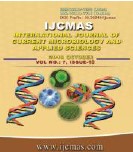


 National Academy of Agricultural Sciences (NAAS)
National Academy of Agricultural Sciences (NAAS)

|
PRINT ISSN : 2319-7692
Online ISSN : 2319-7706 Issues : 12 per year Publisher : Excellent Publishers Email : editorijcmas@gmail.com / submit@ijcmas.com Editor-in-chief: Dr.M.Prakash Index Copernicus ICV 2018: 95.39 NAAS RATING 2020: 5.38 |
Prostatic carcinoma is one of the most common malignancies in the world. Considering the incidence and the mortality of prostate cancer it seems important to study novel biomarkers for prostate cancer diagnosis and progression. Study the immunohistochemical expression of STEAP1 in prostatic adenocarcinoma, HGPIN and benign epithelial lesions of prostate stressing on its role in distinguishing prostatic carcinoma from its benign mimickers. STEAP1 expression was evaluated immunohistochemically in 30 cases of benign prostatic lesions, 8 cases of HGPIN and 40 cases of prostatic adenocarcinoma, and the results was correlated with clinicopathological and histopathological features. Significant difference was detected between STEAP1 expression in benign and malignant prostatic lesions, including prostatic adenocarcinoma and HGPIN, but no significant difference was detected between STEAP1 expression in prostatic carcinoma and HGPIN cases. Moreover, significant relationship was detected between STEAP1 expression and Gleason score of the adenocarcinoma cases. STEAP1 could be considered as an immunohistochemical marker with good sensitivity and considerable specificity for differentiating between benign and malignant prostatic lesions (HGPIN and prostatic adenocarcinoma) but it lacks specificity in distinguishing prostatic adenocarcinoma from HGPIN. STEAP1 might be considered as prognostic marker for prostatic adenocarcinoma and its overexpression was more associated with higher Gleason score.
 |
 |
 |
 |
 |